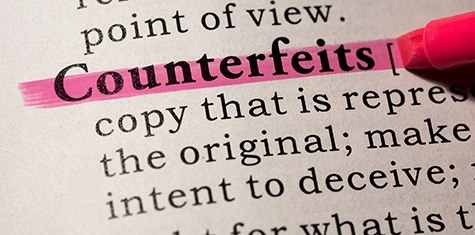By Grant D. Fairbairn & Courtney A. H. Thompson
 Just ask brands like 3M, whose respirator masks were knocked off by an Asian manufacturer that sold products that looked very similar to 3M’s authentic goods, but did not protect workers’ lungs … or 5-Hour Energy®, whose drinks were counterfeited in a filthy, unregulated plant … or Apple, whose phone chargers were knocked off by manufacturers that sold products that started on fire.
Just ask brands like 3M, whose respirator masks were knocked off by an Asian manufacturer that sold products that looked very similar to 3M’s authentic goods, but did not protect workers’ lungs … or 5-Hour Energy®, whose drinks were counterfeited in a filthy, unregulated plant … or Apple, whose phone chargers were knocked off by manufacturers that sold products that started on fire.
These sorts of counterfeiting scenarios can do irreparable harm to a brand. That is why those who have worked so hard to build a brand must protect it.
Obtain Intellectual Property Registrations
Fighting counterfeiters requires foresight and planning. On the front end, companies need to protect new products with intellectual property assets like copyrights, trademarks and design patents in the United States and abroad. If a company is lucky, they might have a year or two before the trickle of counterfeit products becomes a flood.
Monitoring is Easier with New Technology
Monitoring online retailers and stores to ensure no one is selling fakes under your brand’s name is essential. Until recently, this sort of monitoring was onerous. It involved spot-checking stores that advertise your product and pouring over websites to see if there are unauthorized sales occurring both in the United States and internationally.
To make monitoring easier for bigger brands, we have teamed up with a software company called AppDetex, which works with brands and platforms throughout the world to monitor marketplaces, mobile apps and games, websites and social media to ensure they are not being infringed.
Enforcement: Get Tough and, if Necessary, Go to Court
When it comes to enforcement, be aggressive. Start sending out infringement notices as soon as problems appear. The hope is to catch the counterfeiter before it has built up inventory and fallen in love with the illegal revenue stream. Counterfeiters are typically looking for low-hanging fruit. If the legitimate seller makes their lives difficult, they often move on to another product.
We begin by notifying the infringer of our client’s intellectual property assets and demand that they immediately stop selling the knock-off product. This is effective for the vast majority of sellers – most comply and take down the product.
After that first cut, we have a much smaller list of potential problem sellers. We then report those sellers to the host site (e.g. Amazon, eBay, or Alibaba) and demand that the product come down. This second cut will likely remove even more knockoffs. At that point, what are left are the truly bad actors, who are continuing to sell despite having notice of their infringement.
We take the counterfeiters who persist to court. Often these lawsuits are more about following a supply chain to its source than they are about recouping money. Do not despair if your brand’s attacker is overseas. We have been involved in cases where Chinese manufacturers have been put out of business.
During a recent seminar on anti-counterfeiting at our firm, we featured fake-versus-real exhibits that gave attendees the chance to examine real and counterfeit products, including iPhone chargers, Yeti tumblers, CB microphones and more. Most of the fake products were undetectable – until they were used or taken apart.
If your organization has spent time and money on building its brands, it must be proactive about protecting these valuable assets. There are counterfeiters in the United States and abroad looking for opportunities to make money on your carefully managed brand – you must be zealous about stopping them.

